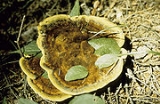
Phaeolus schweinitzii
Encyclopedia
Phaeolus schweinitzii, commonly known as velvet-top fungus, dyer's polypore,Norway Chicken, or dyer's mazegill, is a fungal
plant pathogen that causes butt rot
on conifers such as Douglas-fir, spruce, fir, hemlock
, pine, and larch. P. schweinitzii is a polypore
, although unlike bracket fungi the fruiting body
may appear terrestrial when growing from the roots or base of the host tree. The fruiting bodies, appearing in late summer or fall, commonly incorporate blades of grass, twigs, or fallen pine needles as they grow. As these fruiting bodies age, the pore surface turns from yellow to greenish yellow, the top becomes darker, and the flesh becomes harder and more wood-like.
P. schweinitzii is native to North America
and Eurasia
, and has been identified as an exotic species in New Zealand
, Australia
, and South Africa
.
As its common name suggests, the dyer's polypore is an excellent natural source of green, yellow, gold, or brown dye
, depending on the material dyed and the mordant
used.
P. schweinitzii is named after Lewis David de Schweinitz, a Pennsylvania
-born Moravian minister and important early American
mycologist
.
Fungus
A fungus is a member of a large group of eukaryotic organisms that includes microorganisms such as yeasts and molds , as well as the more familiar mushrooms. These organisms are classified as a kingdom, Fungi, which is separate from plants, animals, and bacteria...
plant pathogen that causes butt rot
Butt rot
thumb|Butt rot of palm, caused by [[Ganoderma zonatum]]Butt rot is a disease of plants, mostly trees, caused by fungi. The fungus attacks the moist, poorly protected undersurface of tree trunk's thickest part , where the end of the stem makes contact with the soil. It may affect the roots as...
on conifers such as Douglas-fir, spruce, fir, hemlock
Tsuga
Tsuga is a genus of conifers in the family Pinaceae. The common name hemlock is derived from a perceived similarity in the smell of its crushed foliage to that of the unrelated plant poison hemlock....
, pine, and larch. P. schweinitzii is a polypore
Polypore
Polypores are a group of tough, leathery poroid mushrooms similar to boletes, but typically lacking a distinct stalk. The technical distinction between the two types of mushrooms is that polypores do not have the spore-bearing tissue continuous along the entire underside of the mushroom. Many...
, although unlike bracket fungi the fruiting body
Basidiocarp
In fungi, a basidiocarp, basidiome or basidioma , is the sporocarp of a basidiomycete, the multicellular structure on which the spore-producing hymenium is borne. Basidiocarps are characteristic of the hymenomycetes; rusts and smuts do not produce such structures...
may appear terrestrial when growing from the roots or base of the host tree. The fruiting bodies, appearing in late summer or fall, commonly incorporate blades of grass, twigs, or fallen pine needles as they grow. As these fruiting bodies age, the pore surface turns from yellow to greenish yellow, the top becomes darker, and the flesh becomes harder and more wood-like.
P. schweinitzii is native to North America
North America
North America is a continent wholly within the Northern Hemisphere and almost wholly within the Western Hemisphere. It is also considered a northern subcontinent of the Americas...
and Eurasia
Eurasia
Eurasia is a continent or supercontinent comprising the traditional continents of Europe and Asia ; covering about 52,990,000 km2 or about 10.6% of the Earth's surface located primarily in the eastern and northern hemispheres...
, and has been identified as an exotic species in New Zealand
New Zealand
New Zealand is an island country in the south-western Pacific Ocean comprising two main landmasses and numerous smaller islands. The country is situated some east of Australia across the Tasman Sea, and roughly south of the Pacific island nations of New Caledonia, Fiji, and Tonga...
, Australia
Australia
Australia , officially the Commonwealth of Australia, is a country in the Southern Hemisphere comprising the mainland of the Australian continent, the island of Tasmania, and numerous smaller islands in the Indian and Pacific Oceans. It is the world's sixth-largest country by total area...
, and South Africa
South Africa
The Republic of South Africa is a country in southern Africa. Located at the southern tip of Africa, it is divided into nine provinces, with of coastline on the Atlantic and Indian oceans...
.
As its common name suggests, the dyer's polypore is an excellent natural source of green, yellow, gold, or brown dye
Natural dye
Natural dyes are dyes or colorants derived from plants, invertebrates, or minerals. The majority of natural dyes are vegetable dyes from plant sources – roots, berries, bark, leaves, and wood — and other organic sources such as fungi and lichens....
, depending on the material dyed and the mordant
Mordant
A mordant is a substance used to set dyes on fabrics or tissue sections by forming a coordination complex with the dye which then attaches to the fabric or tissue. It may be used for dyeing fabrics, or for intensifying stains in cell or tissue preparations. The term mordant comes from the Latin...
used.
P. schweinitzii is named after Lewis David de Schweinitz, a Pennsylvania
Pennsylvania
The Commonwealth of Pennsylvania is a U.S. state that is located in the Northeastern and Mid-Atlantic regions of the United States. The state borders Delaware and Maryland to the south, West Virginia to the southwest, Ohio to the west, New York and Ontario, Canada, to the north, and New Jersey to...
-born Moravian minister and important early American
United States
The United States of America is a federal constitutional republic comprising fifty states and a federal district...
mycologist
Mycology
Mycology is the branch of biology concerned with the study of fungi, including their genetic and biochemical properties, their taxonomy and their use to humans as a source for tinder, medicinals , food and entheogens, as well as their dangers, such as poisoning or...
.

